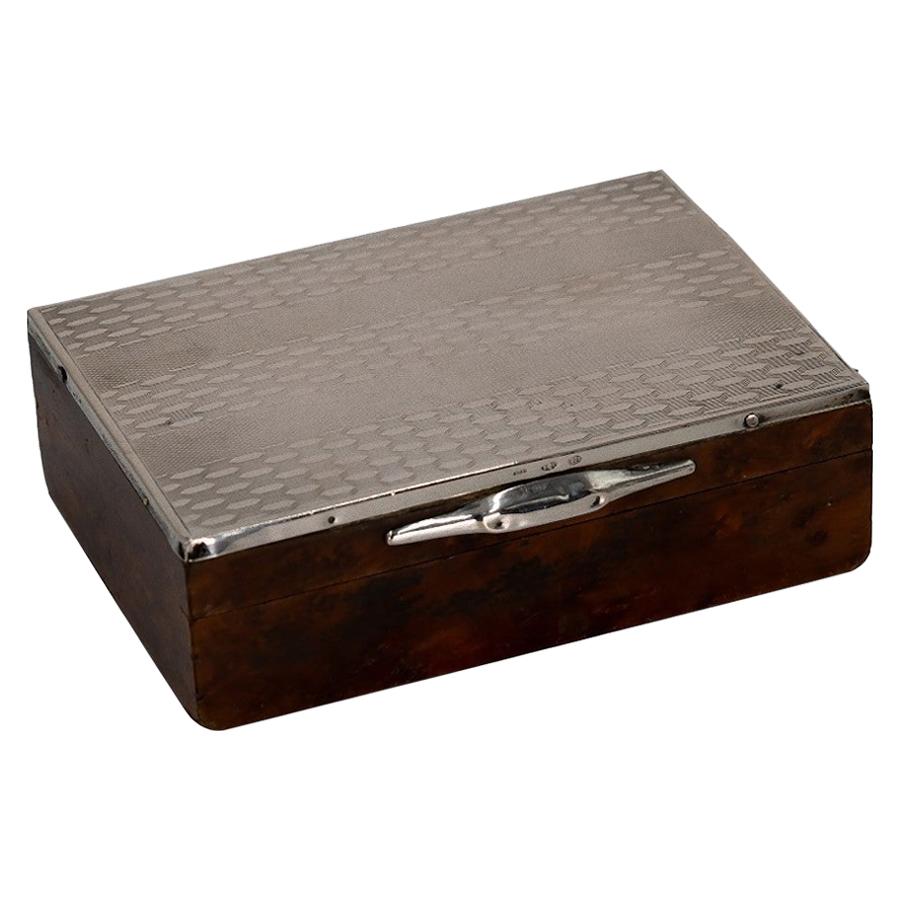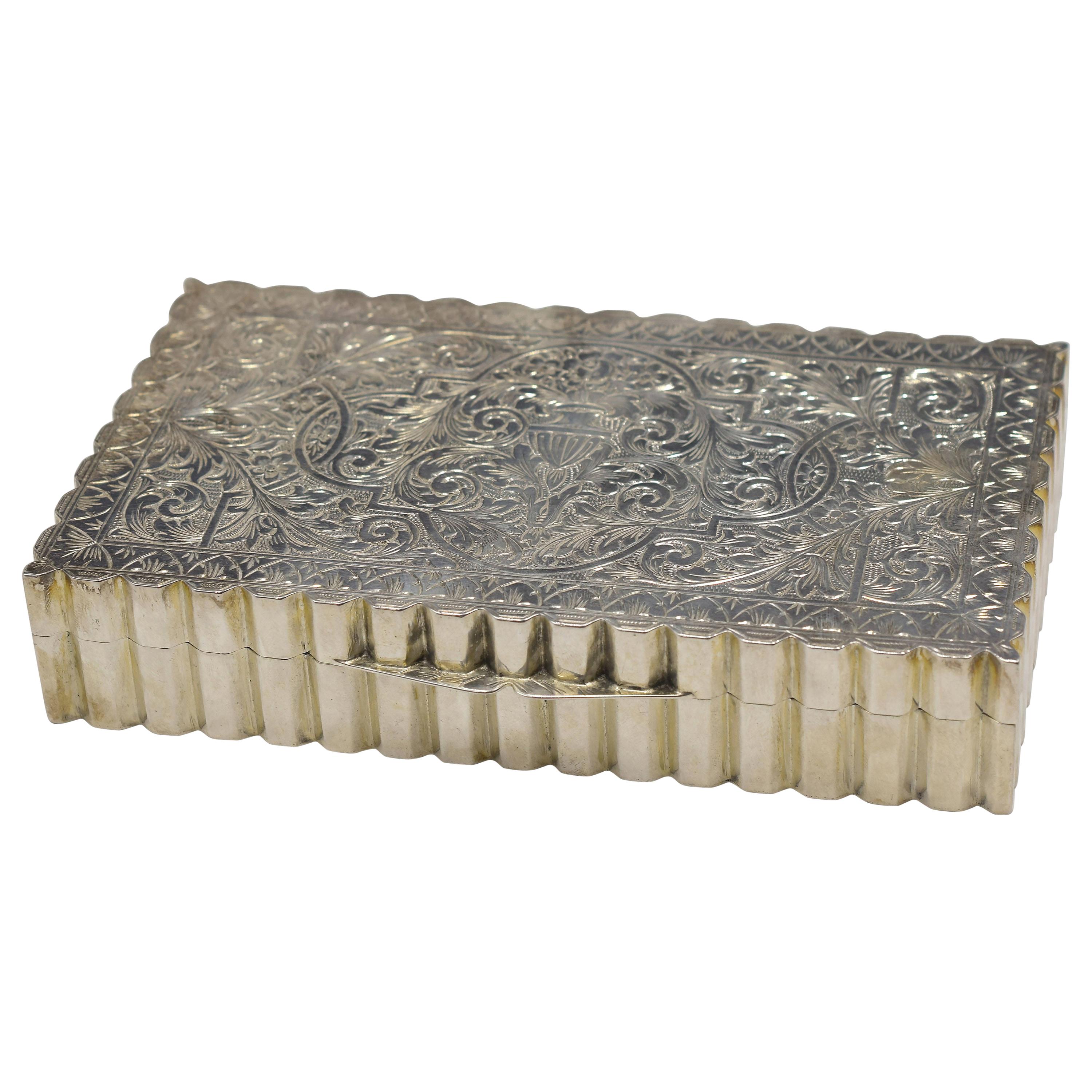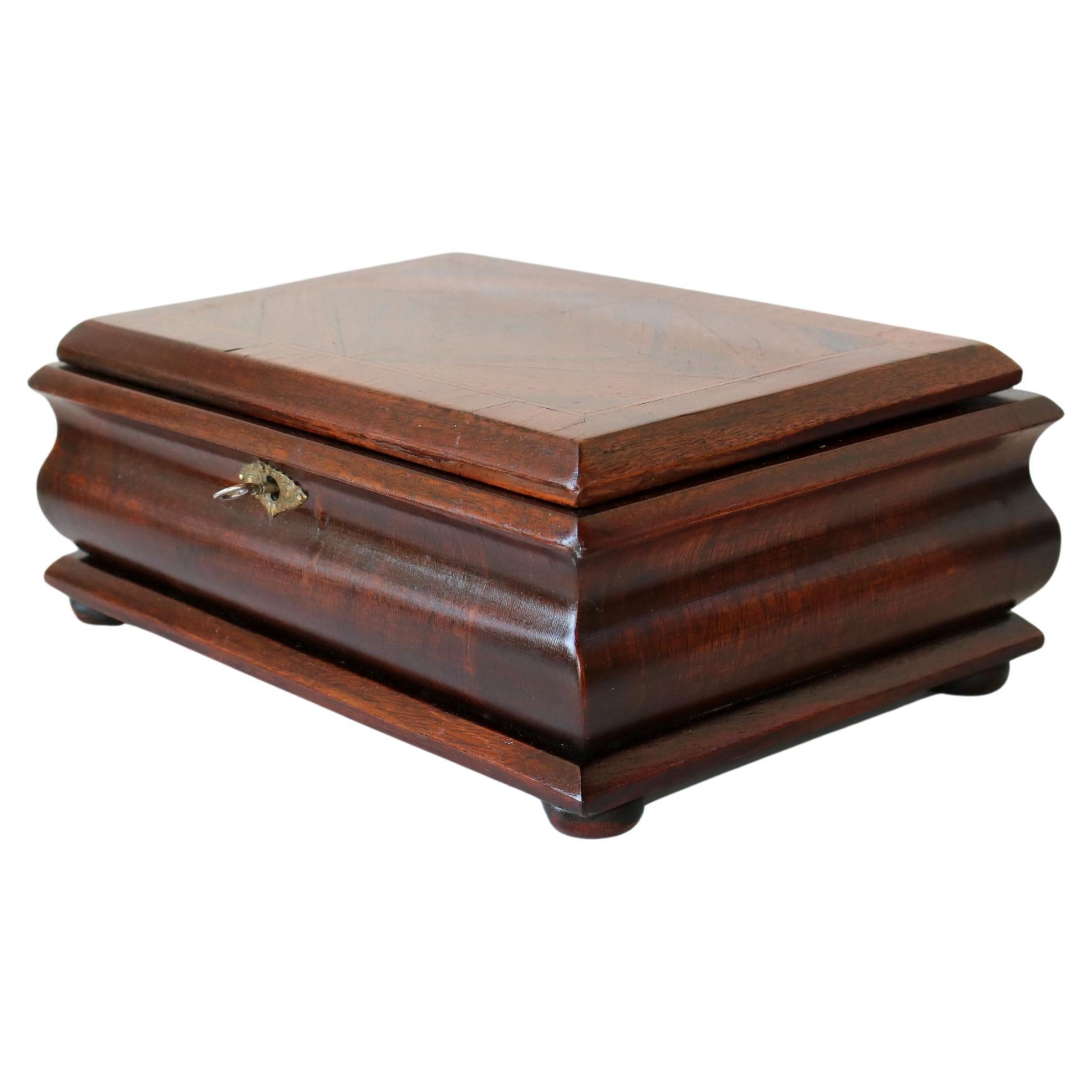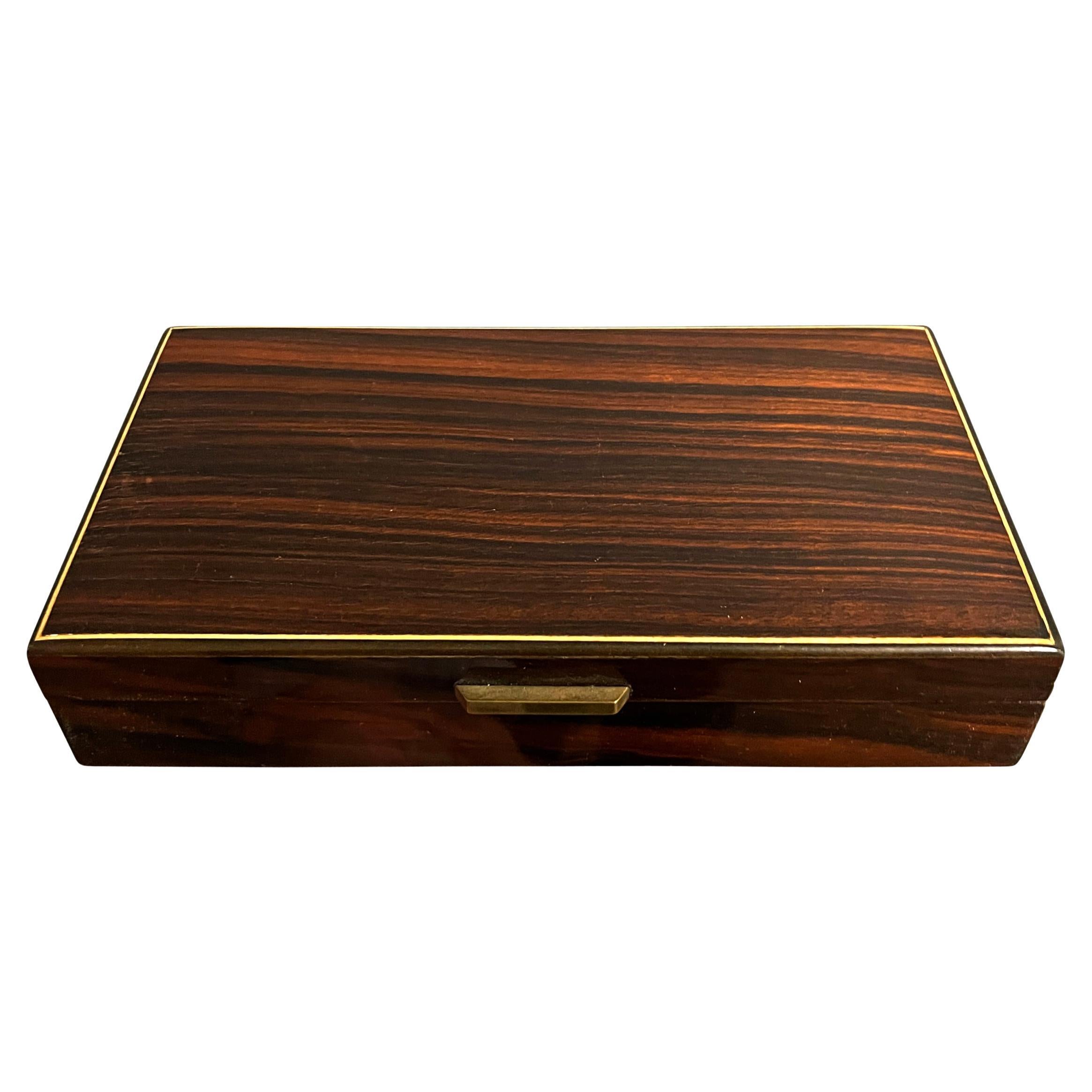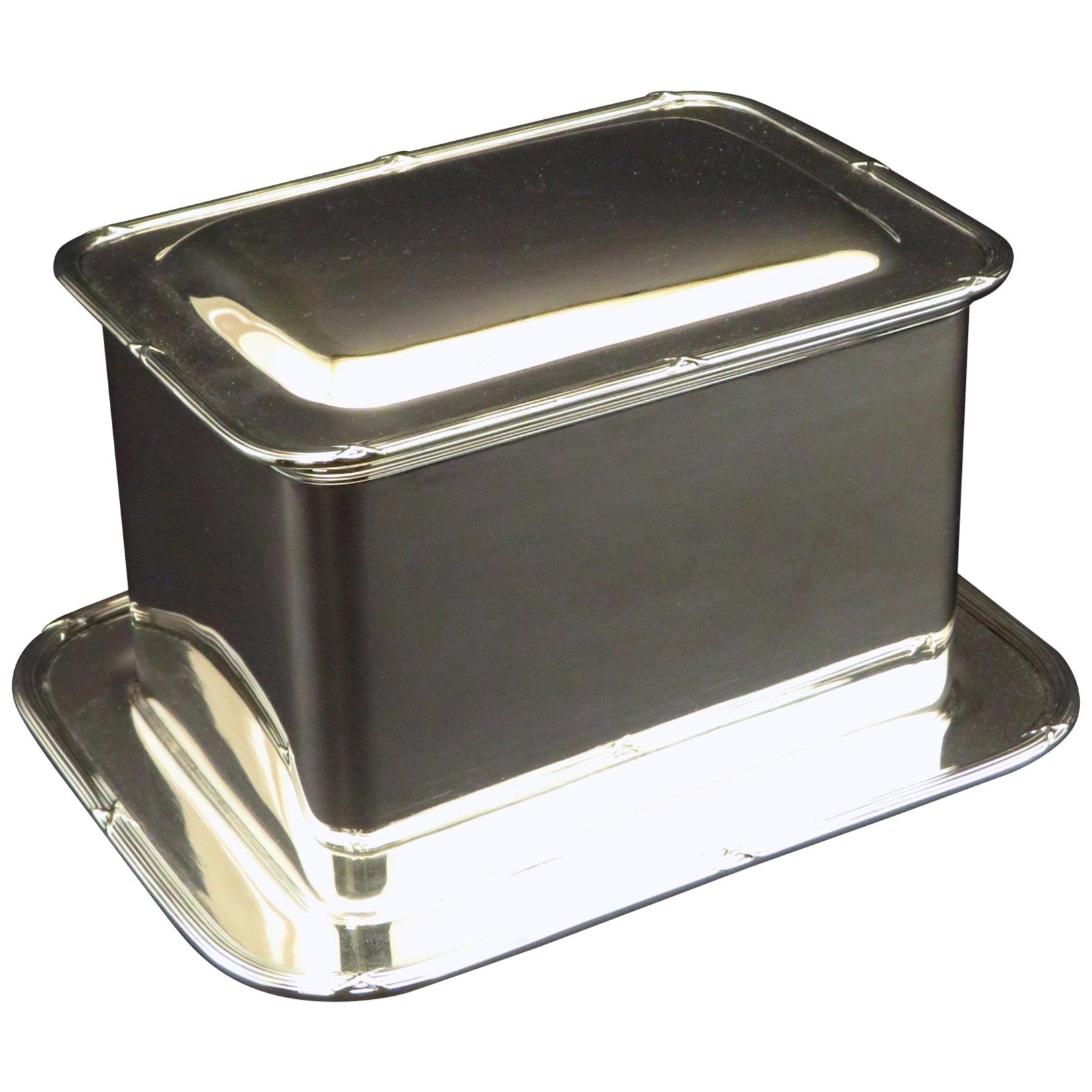Items Similar to Silver Plated Keepsake Box, Early 20th Century
Want more images or videos?
Request additional images or videos from the seller
1 of 6
Silver Plated Keepsake Box, Early 20th Century
About the Item
Offered is a silver plated keepsake box, dating to the early 1900s. The hallmarked box offers great storage solution for jewelry, cufflinks, and other keepsakes, with a divided interior. A well maintained, elegant piece, this antique silver box is an excellent addition to any silver collection.
Trinket or keepsake boxes have taken on many forms since their first conception in ancient times. However their purpose remains the same; to store jewelry and other items precious to the owner. Originally, these boxes were used specifically for jewelry. These were in common use as early as 5000 BC in Ancient Egypt, when the majority of Egyptians, both male and female, wore jewelry. Boxes were used to keep these gemstone encrusted items safe. In Ancient Rome, jewelry was a status symbol. Rings and brooches were utilized to represent ones status in society. Again, boxes were needed for security and storage purposes. Finding early examples of these are quite rare.
Victorian and Edwardian examples of trinket boxes are far more common. This is because owning jewellery was a luxury until the Victorian era- let alone possessing so much a box was needed to store it all. Fine jewelry and other items became available to the masses after the industrial revolution due to the reduction in production costs. This led to a demand for trinket boxes, which were much smaller than jewelry boxes and therefore better suited to the needs of the middle class who did not yet possess an abundance of jewelry.
In Victorian households, collectables and other items of interested were also stashed inside these boxes. This is why they are known as trinket or keepsake boxes, rather than just jewelry boxes, although of course jewelry was also stored in them. Trinket boxes were produced in large numbers around this time. Many were lined with colored plush or velvet or rich wood. More elaborate designs had interior divisions and trays for rings and other pieces of jewellery. It was also common to see trinket boxes so small that they could only contain one item, such as a single ring. Ornate exteriors were created to reflect the value of the trinket boxes contents.
The Edwardian era saw the introduction of new styles of trinket box. These included small circular or oblong boxes that stood on cabriole legs. These often featured lids made of tortoiseshell or other luxurious materials. In the 1900s through the 1930's more streamlined and modern Art Deco styles became popular.
CONDITION:
Overall very good condition. Hinged lid. Gentle use, some light visible wear to divided interior, but otherwise quite well maintained. Hallmarked.
Dimensions: 2" H x 6 1/2" W x 3 7/8" D.
- Dimensions:Height: 2 in (5.08 cm)Width: 6.5 in (16.51 cm)Depth: 3.88 in (9.86 cm)
- Materials and Techniques:
- Place of Origin:
- Period:1900-1909
- Date of Manufacture:1900s
- Condition:Wear consistent with age and use.
- Seller Location:Colorado Springs, CO
- Reference Number:
About the Seller
4.9
Platinum Seller
These expertly vetted sellers are 1stDibs' most experienced sellers and are rated highest by our customers.
Established in 2010
1stDibs seller since 2011
400 sales on 1stDibs
Typical response time: <1 hour
- ShippingRetrieving quote...Ships From: Colorado Springs, CO
- Return PolicyA return for this item may be initiated within 10 days of delivery.
More From This SellerView All
- Hallmarked Silver Plated Keepsake Box, Sheffield, Uk, Circa 1900Located in Colorado Springs, COOffered is a stunning Sheffield silver keepsake box dating to 1900, with associated hallmark. This small box includes a clean interior and rounded corners. The box is free of names or initials, but would have been used to house keepsakes such as jewelry or cufflinks. A well maintained, elegant piece, this antique silver box is an excellent addition to any silver collection. Trinket or keepsake boxes have taken on many forms since their first conception in ancient times. However their purpose remains the same; to store jewelry and other items precious to the owner. Originally, these boxes were used specifically for jewelry. These were in common use as early as 5000 BC in Ancient Egypt, when the majority of Egyptians, both male and female, wore jewelry. Boxes were used to keep these gemstone encrusted items safe. In Ancient Rome, jewelry was a status symbol. Rings and brooches were utilized to represent ones status in society. Again, boxes were needed for security and storage purposes. Finding early examples of these are quite rare. Victorian and Edwardian examples of trinket boxes are far more common. This is because owning jewellery was a luxury until the Victorian era- let alone possessing so much a box was needed to store it all. Fine jewelry and other items became available to the masses after the industrial revolution due to the reduction in production costs. This led to a demand for trinket boxes, which were much smaller than jewelry boxes and therefore better suited to the needs of the middle class who did not yet possess an abundance of jewelry. In Victorian households, collectables and other items of interested were also stashed inside these boxes. This is why they are known as trinket or keepsake boxes, rather than just jewelry boxes, although of course jewelry was also stored in them. Trinket boxes were produced in large numbers around this time. Many were lined with colored plush or velvet or rich wood. More elaborate designs had interior divisions and trays for rings and other pieces of jewellery. It was also common to see trinket boxes so small that they could only contain one item, such as a single ring. Ornate exteriors were created to reflect the value of the trinket boxes contents. The Edwardian era saw the introduction of new styles of trinket box. These included small circular or oblong boxes...Category
Antique Early 1900s British Art Deco Decorative Boxes
MaterialsSilver
- Hallmarked Silver Plated Keepsake Box, Sheffield, UK, circa 1900Located in Colorado Springs, COOffered is a stunning silver plated keepsake box dating to 1900, with associated hallmark. This small box includes a wooden interior with two slots and a blank square on top where initials could have been engraved. A well maintained, elegant piece, this antique silver box is an excellent addition to any silver or home decor collection. Trinket or keepsake boxes have taken on many forms since their first conception in ancient times. However their purpose remains the same; to store jewelry and other items precious to the owner. Originally, these boxes were used specifically for jewelry. These were in common use as early as 5000 BC in Ancient Egypt, when the majority of Egyptians, both male and female, wore jewelry. Boxes were used to keep these gemstone encrusted items safe. In Ancient Rome, jewelry was a status symbol. Rings and brooches were utilized to represent ones status in society. Again, boxes were needed for security and storage purposes. Finding early examples of these are quite rare. Victorian and Edwardian examples of trinket boxes are far more common. This is because owning jewellery was a luxury until the Victorian era- let alone possessing so much a box was needed to store it all. Fine jewelry and other items became available to the masses after the industrial revolution due to the reduction in production costs. This led to a demand for trinket boxes, which were much smaller than jewelry boxes and therefore better suited to the needs of the middle class who did not yet possess an abundance of jewelry. In Victorian households, collectables and other items of interested were also stashed inside these boxes. This is why they are known as trinket or keepsake boxes, rather than just jewelry boxes, although of course jewelry was also stored in them. Trinket boxes were produced in large numbers around this time. Many were lined with colored plush or velvet or rich wood. More elaborate designs had interior divisions and trays for rings and other pieces of jewellery. It was also common to see trinket boxes so small that they could only contain one item, such as a single ring. Ornate exteriors were created to reflect the value of the trinket boxes contents. The Edwardian era saw the introduction of new styles of trinket box. These included small circular or oblong boxes...Category
Antique Early 1900s English Art Deco Decorative Boxes
MaterialsSilver
- American Hand-Carved Folk Eagle, Early to Mid 20th CenturyLocated in Colorado Springs, COThis is a stunning early to mid 20th century hand-carved bald eagle. The eagle is carved out of one large piece of wood, making the intricate detailing on the feathers and beak that ...Category
Early 20th Century American Federal Wall-mounted Sculptures
MaterialsWood, Paint
- 46-Star American Flag, Antique Printed on Silk, Early 20th CenturyLocated in Colorado Springs, COThis is an original 46-star American parade flag, printed on silk. Each star represents a state in the Union at the time. The official flag design would update every July 4th, to inc...Category
Antique Early 1900s American Political and Patriotic Memorabilia
MaterialsSilk
- Antique 13-Star Patriotic Sash by Louis E. Stilz & Bros., Early 20th CenturyLocated in Colorado Springs, COPresented is an original patriotic sash from the early 20th century, featuring 13 stars against a bright blue field. This sash features appliqued silver stars on a blue canton, red a...Category
Early 20th Century American Historical Memorabilia
MaterialsCotton
- Bellamy Style Hand-Carved New England Pine Eagle, Early to Mid-20th CenturyLocated in Colorado Springs, COThis is an original American eagle, hand-carved from pine during the early to mid 20th century. The eagle features a touch of original gilt over yellow sizing with hand-painted highlights, emphasizing the eyes and beak. The eagle is displayed with both wings fully outstretched. The feathers are expertly detailed, especially considering that this eagle is a single-piece carving. The eagle is both the national bird and the national animal of the United States. The founders of the United States were fond of comparing their new republic with the Roman Republic, in which eagle imagery, usually the golden eagle, was prominent. On June 20, 1782, the Continental Congress adopted the design for the Great Seal of the United States depicting a bald eagle grasping 13 arrows in its sinister (left) talon and an olive branch with its dexter (right) talons. Those arrows are tightly aligned, a symbol of "strength in unity" that's found in the traditional cultures everywhere, from the Romans to the Iroquois. In this case, the bundle of arrows were a nod to the unity of the original 13 colonies. The olive branches emphasize the power of peace. The eagle motif has since appeared in allegorical engravings...Category
Early 20th Century American Sculptures and Carvings
MaterialsPine
You May Also Like
- Vintage Silver Box, Early 20th CenturyLocated in Roma, ITVintage silver box is a precious decorative object realized in the early 20th century. Very elegant box in silver, finely decorated on the top with a very elegant geometric decora...Category
Vintage 1920s European Decorative Boxes
MaterialsSilver
- Vintage Silver Box, Early 20th CenturyLocated in Roma, ITVintage silver box is a precious decorative object realized in 20th century. Very elegant box in silver, made at the beginning of 1900s. Finely decorated on the top with a very...Category
Early 20th Century European Decorative Boxes
MaterialsSilver
- Early 20th Century Faceted Glass & Silver Plated Biscuit Box, c.1920By John Grinsell & SonsLocated in Bath, GBA heavy piece of glass was used to create this quality example, faceted all the way around and series of simple linear cuts around the circumference; the underside having a star cut....Category
Vintage 1910s English Art Deco Decorative Boxes
MaterialsSilver Plate
- Early 20th Century Cigar BoxLocated in Lučenec, SKA very nice cigar box suitable to any smoking room with ample space even for the biggest cigars and accessories.Category
Antique Early 1900s German Late Victorian Cigar Boxes and Humidors
MaterialsWood
- Early 20th Century Austrian BoxLocated in Chicago, ILA striking early 20th century Austrian box with ebony veneer over birch and with a thin fruitwood inlaid stripe around the lid. A simple brass handle allows the lid to be opened. Per...Category
Early 20th Century Austrian Decorative Boxes
MaterialsEbony, Fruitwood
- Early 20th Century Silver Plated Biscuit Box / Humidor by Mappin & Webb, EnglandBy Mappin & WebbLocated in Ottawa, OntarioA very handsome silver plated biscuit box or humidor of timeless design, having a rectangular body with a hinged and partially domed lid trimmed with a neoclassical inspired reeded e...Category
Early 20th Century English Neoclassical Revival Decorative Boxes
MaterialsSilver Plate
Recently Viewed
View AllMore Ways To Browse
Limoges Egg Shaped Ring Box
Vintage Jewelry Music Box
Malachite Dresser
Antique Valet Box
Antique Wooden Vanity Box
Vintage Wood Puzzle Box
Dresser Casket
White Porcelain Painted Jewelry Box France
Straw Work Prisoner Of War
Antique Silver Nail File
Pink Marble Jewelry Box
Small Acrylic Pill
Birks Box
French Provincial Jewelry Box
Hot Gentleman
Venetian Jewelry Box
Antique Ivory Trinket Boxes
Antique Wooden Box With Secret Compartment
